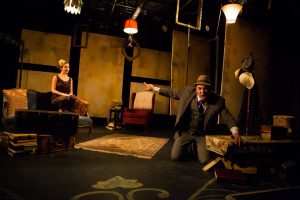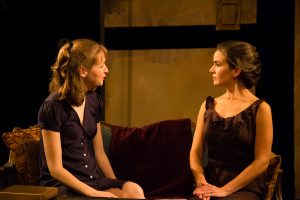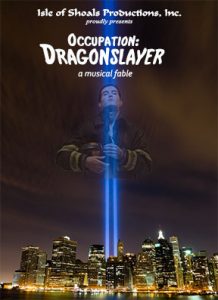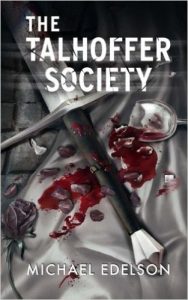Suggested by Alexander Pushkin’s “Eugene Onegin,” Isle of Shoals‘ world premiere of Bryan William’s latest work, “Alex & Eugene,” is showing now through September 2nd at the Robert Moss Theatre in Astor Place.
Set in a contemporary New York City, this musical tells the tale of a love-filled band of vibrant young performers struggling to navigate careers, both personally and professionally. Set to a sweepingly diverse score by Williams – that is alternately jaunty and heartbreaking – our plucky crew encounters a sufficiently-dramatic degree of success… as well as tragic failure.
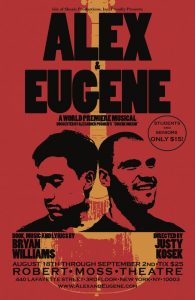
And “tragic” is no understatement, as the warning in the program hints:
“Please Note: Alex & Eugene is for mature audiences and contains partial nudity, gunshot sound effects, strong language and suicidal content.”
Without the warning, you would never see where the story was going from how it begins. The frivolity, joie de vivre, and outright fun had in the first part of the show sets a brutally effective counterpoint for the unfortunate turns of fate awaiting our characters later on.
In this way, Williams paints a Bob Ross still-life of a story, balancing broad strokes with minute details, so that the ultimate product is as viscerally gripping as it is intriguing, thought provoking, and inward-looking.
Eugene is played by Reggie Herold, who’s bone structure would indicate he is the son of Michelangelo’s left and right hands. Not only does he cut a mean profile, but he’s a powerful force on stage, often telling an entire story with a single glance – beginning, middle, and end. And sometimes an epilogue. (Once, also a trailer for the sequel.)
He’s an exciting actor to watch, especially opposite his co-star, Alex, played by Jae Shin. Shin’s performance as a stunted, socially-awkward struggling writer-type is as convincing as it is heartbreaking. Plus he plays guitar!
Anna Stefanic plays Tanya, Alex’s “twin” sister, and she is just as alight and engaging when off-focus as she is when taking center stage. I found myself watching her during other people’s performances just to see what she was doing – and was always entertained. Stefanic also has an incredible voice, uniquely deep and warm, mellifluous, like a tidal wave made of sunlight.
Independent love interest Esmé is played by the lovely Brittany Zeinstra, who radiates a sense of genuine authenticity and fully-formed personhood from head-to-toe, start-to-finish. Zeinstra demonstrates with aplomb the dynamic fluctuations her voice is capable of, somehow weaving together an endearingly sweet Rogers & Hammerstein style with the modern twang of Country Western, forming something new and beautiful, with a tone and character all her own.
Katherine Leidlien (Janie/Lana) and Noah Pyzik (Brandon/Chuck) get a nice featuring of their talents and delightful personalities in the song, “Not My Gay Best Friend,” which is not only cute, but feels wholly authentic. They became for me during that song two people I knew, friends of mine, and were no longer actors portraying characters.
Aja Downing, who plays another performer in the group, Cassandra, is naturally hilarious and it shines clearly through her performance. Her sweet, rich, and velvety voice in “Tell Him” offers glimpses at a hidden power beneath the surface….
The choreography by Alex Johnson is fresh, intelligent, and fun, and manages to tell the story as easily as it does elegantly.
The show makes a thing out of breaking the Fourth Wall, and no where is it used better than while the cast and crew moves set pieces around in the dark between scenes. When they do, we can hear the characters ad libbing with one another, and it serves to help keep us in the story at the precise time we’re likely to come out of it. When something happened to go audibly wrong during one set change, the slight malfunction became a hilarious moment of honesty, rather than merely a mistake.
The set utilized a clever series of benches that converted into ramps, and though I found them quite ingenious and well-used, they didn’t always appear to be super stable.
And don’t THINK I didn’t notice the Star Wars novel on the book shelf, Scenic Designer Jennilee Aromando! Props (pun intended).
Williams’ music uses sturdy melodies to support some truly masterfully-crafted vocal harmonies, reason enough to see the show right there. The whole soundtrack is an enchanting assortment that flows, changes, evolves, and ultimately spreads its wings and soars away into the sky. Some of the dialogue, meanwhile, doesn’t land as gracefully. To abuse a quote from the show: “‘Obdurate,’ Alex? Who says that?!”
Also to great theatrical effect, Williams takes full advantage of his own profound sonic talents by harnessing the negative space his music creates – well-placed silence.
Though it suffers from being a bit too long, “Alex & Eugene” does an expert job of setting up your emotional dominoes so it can topple them back down again in way that will resound in your soul. It tells an important story with a responsible touch, aiming to spread awareness, understanding, and love.
